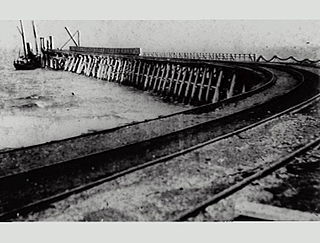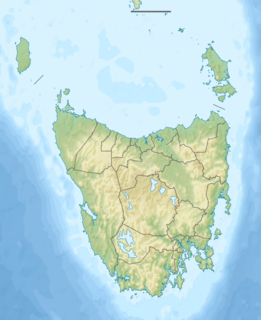
The passenger ship SS Yongala sank off Cape Bowling Green, Queensland, Australia on 23 March 1911. En route from Melbourne to Cairns she steamed into a cyclone and sank south of Townsville. All 122 aboard died, and traces of the ship were not found until days later, when cargo and wreckage began to wash ashore at Cape Bowling Green and at Cleveland Bay. It was believed that the hull of the ship had been ripped open by a submerged rock. The wreck, which has become a tourist attraction and dive site, was not found until 1958.

TSS Kanowna, was an Australian steamer built during 1902. The 6,993-ton, 126-metre (413 ft) long Kanowna was constructed by William Denny and Brothers of Dumbarton, Scotland, and had a twin screw design.

The Clarke Island, part of the Furneaux Group, is an 82-square-kilometre (32 sq mi) island in Bass Strait, south of Cape Barren Island, about 24 kilometres (15 mi) off the northeast coast of Tasmania, Australia.

SS Waratah was a passenger and cargo steamship built in 1908 for the Blue Anchor Line to operate between Europe and Australia. In July 1909, on only her second voyage, the ship, en route from Durban to Cape Town, disappeared with 211 passengers and crew aboard. No trace of the ship has ever been found.

HMAS Jervis Bay was a roll-on/roll-off passenger and vehicle ferry operated by the Royal Australian Navy (RAN) between 1977 and 1994.
Duke of Roxburgh was launched in 1828 at Newcastle upon Tyne. Initially she traded with India, but later she often sailed between Great Britain and her Australasian colonies carrying emigrants. She was wrecked in 1864.

HMS Buffalo was a storeship of the Royal Navy, originally built and launched at Sulkea, opposite Calcutta, in 1813 as the merchant vessel Hindostan. The Admiralty purchased her that year after she arrived in Britain. She later transported convicts and immigrants to Australia, before being wrecked in 1840.

SS Suevic was a steamship built by Harland and Wolff in Belfast for the White Star Line. Suevic was the fifth and last of the Jubilee Class ocean liners, built specifically to service the Liverpool-Cape Town-Sydney route, along with her sister ship SS Runic. In 1907 she was wrecked off the south coast of England, but in the largest rescue of its kind, all passengers and crew were saved. The ship herself was deliberately broken in two, and a new bow was attached to the salvaged stern portion. Later serving as a Norwegian whaling factory ship carrying the name Skytteren, she was scuttled off the Swedish coast in 1942 to prevent her capture by ships of Nazi Germany.

SS City of Launceston was a 368 GRT steamship operated by the Launceston and Melbourne Steam Navigation Company from 1863, which had an early role in colonial steam shipping as the forerunner of the modern Bass Strait ferry service between Tasmania and Victoria. It was sunk in Port Phillip Bay after a collision with another ship on 19 November 1865.
George was an Australian sloop launched in 1802 and wrecked in 1806. She spent her brief career seal hunting in Bass Strait.
Daphne was a brig constructed in Java that arrived in Australia in 1814. She was wrecked without loss of life on 26 October 1819 in the Kent Group in Bass Strait. She was on a voyage from Port Jackson to India.

Crusader (AV2767) was an Australian Army amphibious operations support ship of World War II. She was launched shortly before the war ended and entered service in late 1945. From 1945 to 1947 she was mainly used to return Australian Army equipment from the islands off New Guinea. She was also loaned to the Australian Shipping Board in early 1947 and transported earth moving equipment and timber between Melbourne and Tasmania. However, the Army did not need a ship with Crusader's capabilities after the war, and she was sold in 1947 to the Queensland Cement and Lime Company which operated her as a coral barge on the Brisbane River until the mid-1980s. The ship was scuttled in 1986 and became a popular dive wreck.
The Eleanor Lancaster was a 3-masted barque built at Maryport in 1839. Launched in 1840, and initially registered in Liverpool, it was operated by David Laidman (named after his wife, Eleanor Ann Hannah née Lancaster, with Captain P.Cowley as captain. In 1845, the ship was re-registered in London and was operated by Soutter & Co, with Captain Francis Lodge in command.

The Fitzroy was a steel-hulled steamship built in 1912 at Old Kilpatrick, Scotland in 1912. She was wrecked and lost when she capsized in a gale whilst carrying a general cargo between Coffs Harbour and Sydney off Cape Hawke, New South Wales on 26 June 1921.
Grace was launched at Ipswich in 1811. She spent most of her career sailing to South America. However, she was returning to Britain from New South Wales in 1822 when a fire that started in her cargo destroyed her.
Actaeon was launched at Fort Gloster, India, in 1815. She was wrecked without loss of life on 28 October 1822 in the D'Entrecasteaux Channel in southern Tasmania.

The Merksworth was an iron steamer screw built in 1874 at, Paisley, that was wrecked when it swamped whilst carrying coal between Newcastle and Sydney and was lost off Newcastle, Stockton Beach, New South Wales on 7 May 1898.
Hadlow was a merchant sailing ship built in 1814 at Quebec, British North America. She made two voyages transporting convicts from England and Ireland to Australia. She plied between England, India, and Sierra Leone before being lost with all hands in 1823.
Caledonia was a merchant ship built in British India in 1829. She traded between India, China, Mauritius, and the Australian Colonies. She played an important role in the development of King George Sound. She made two voyages transporting convicts, one voyage from Madras and the other from Swan River Colony, both to Sydney, Australia. After her sale in 1840 her registry shifted to London and she became a general trader. She was last listed in 1855.
Phoenix was a merchant vessel launched in 1810 The British East India Company (EIC) chartered her to make one voyage to Madras and Bengal between 1820 and 1821. She then made one voyage transporting convicts to Tasmania in 1822, and two to New South Wales, one in 1826 and one in 1828. She was wrecked in 1829.














